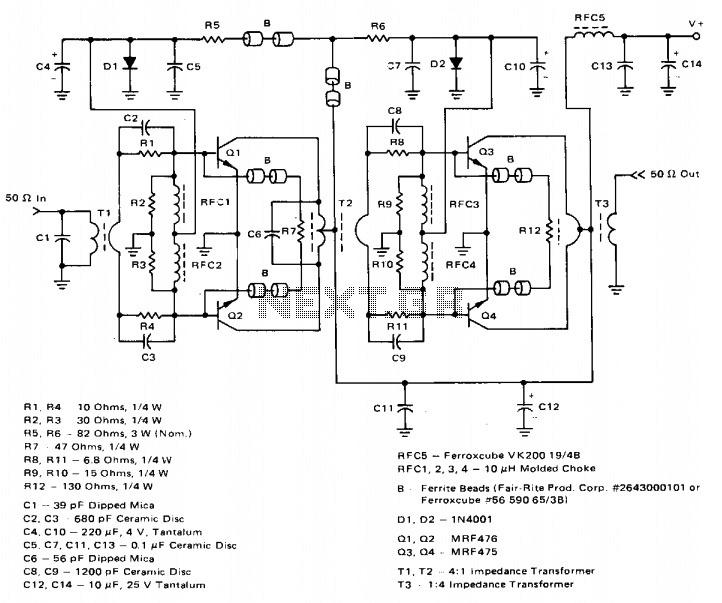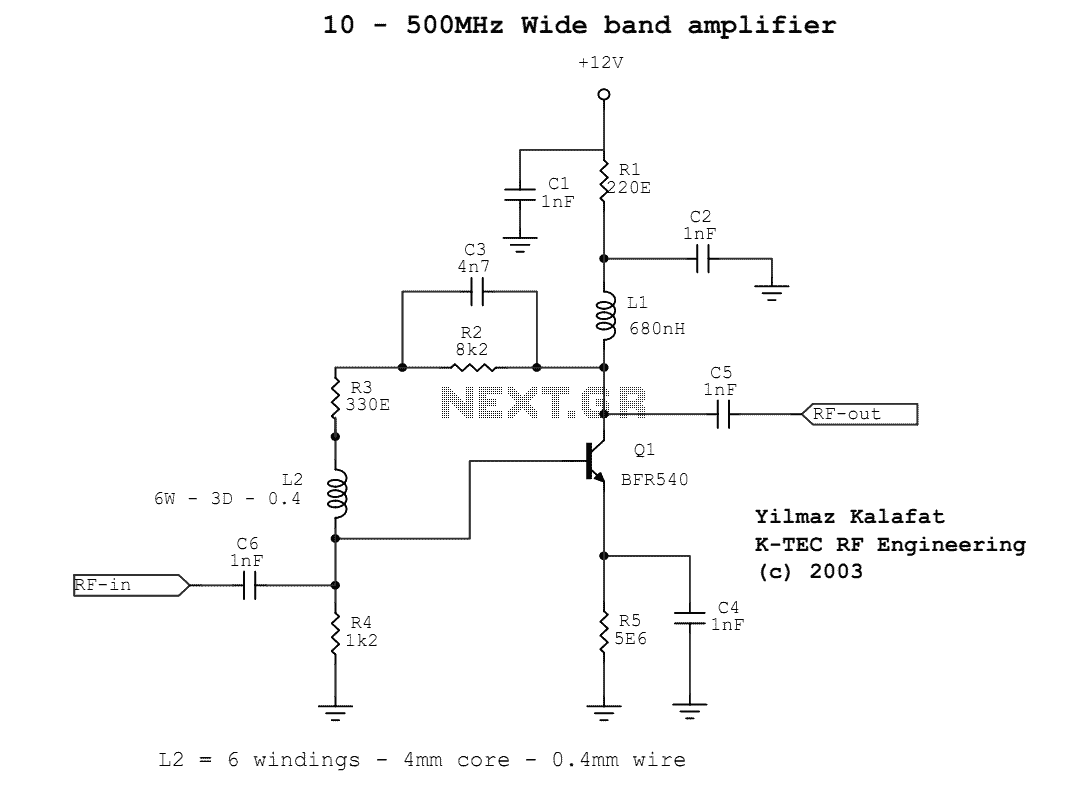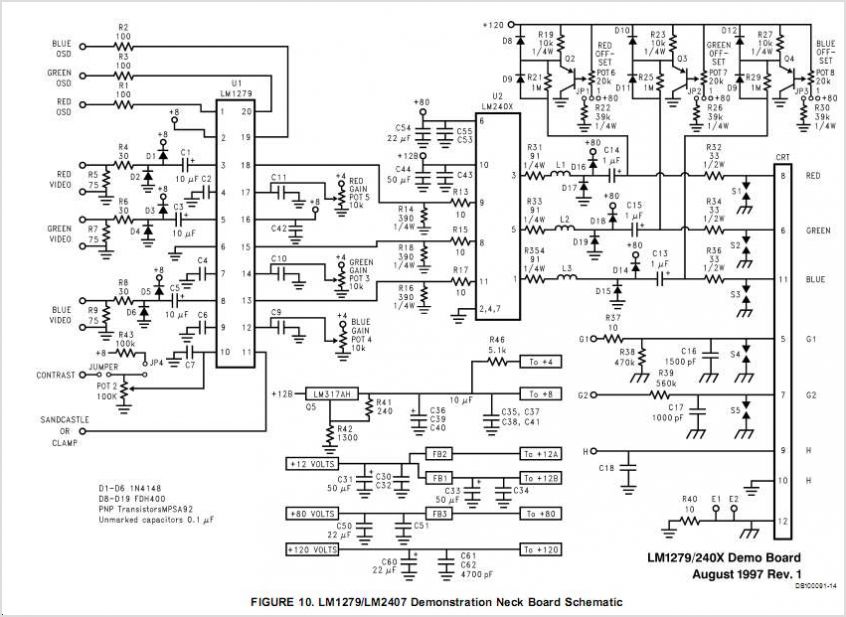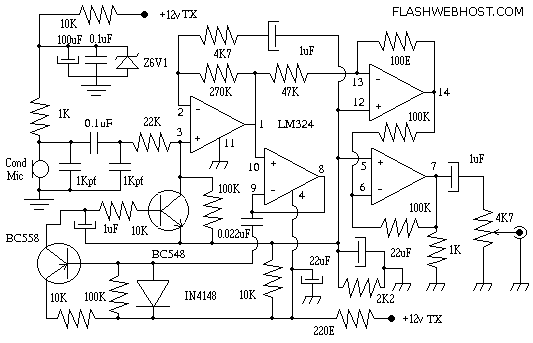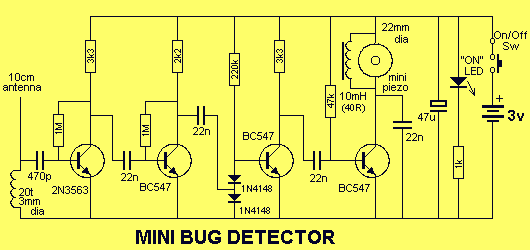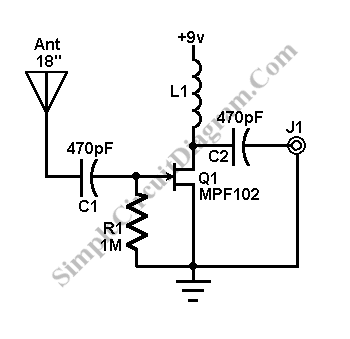
Active Antenna for 10 to 30 MHz

The schematic shown is a 2 transistor signal amplifier between 10 MHz to 30 MHz. The BF256C and the BF494 are very popular transistors and are easy to find. The transformer works as insulator and amplifier. That circuit can give 20 dB gain. The variable capacitor is for exact tuning at the favorite radio station. The circuit can be powered by a 9 to 12V power supply and because the current consumption is too small like 5mA you can use batteries.
The described circuit is a two-transistor signal amplifier designed for operation within the frequency range of 10 MHz to 30 MHz. It utilizes the BF256C and BF494 transistors, both of which are well-known for their availability and performance in RF applications. The circuit achieves a gain of approximately 20 dB, making it suitable for amplifying weak radio signals for clearer reception.
The configuration incorporates a transformer, which serves a dual purpose: it acts as an insulator to prevent DC signals from affecting the input and output stages, and it also contributes to the amplification of the RF signal. This transformer is crucial in ensuring that the circuit can effectively couple signals while maintaining isolation between different stages and minimizing signal loss.
A variable capacitor is included in the design, allowing for fine-tuning of the circuit to optimize reception of the desired radio station. This tuning capability is essential for enhancing selectivity and ensuring that the amplifier can effectively filter out unwanted frequencies.
Power supply requirements for the circuit are flexible, accommodating a range of 9 to 12 volts. The low current consumption of approximately 5 mA makes this circuit particularly suitable for battery operation, enhancing its portability and ease of use in various applications, including portable radio receivers and other RF signal processing devices.
Overall, the design is straightforward yet effective, making it an ideal choice for hobbyists and professionals looking to build a reliable RF amplifier.The schematic shown, is a 2 transistor signal amplifier between 10 MHz to 30 MHz. The BF256C and the BF494 are very popular transistors and are easy to find. The transformer works as insulator and amplifier. http://www.next.gr/rf/antennas/active-antennas/ That circuit can give 20 dB gain. The variable capacitor is for exact tuning at the favorite radio station. The circuit can be powered by a 9 to 12V power supply and because the current consumption is too small like 5mA you can use batteries.
The described circuit is a two-transistor signal amplifier designed for operation within the frequency range of 10 MHz to 30 MHz. It utilizes the BF256C and BF494 transistors, both of which are well-known for their availability and performance in RF applications. The circuit achieves a gain of approximately 20 dB, making it suitable for amplifying weak radio signals for clearer reception.
The configuration incorporates a transformer, which serves a dual purpose: it acts as an insulator to prevent DC signals from affecting the input and output stages, and it also contributes to the amplification of the RF signal. This transformer is crucial in ensuring that the circuit can effectively couple signals while maintaining isolation between different stages and minimizing signal loss.
A variable capacitor is included in the design, allowing for fine-tuning of the circuit to optimize reception of the desired radio station. This tuning capability is essential for enhancing selectivity and ensuring that the amplifier can effectively filter out unwanted frequencies.
Power supply requirements for the circuit are flexible, accommodating a range of 9 to 12 volts. The low current consumption of approximately 5 mA makes this circuit particularly suitable for battery operation, enhancing its portability and ease of use in various applications, including portable radio receivers and other RF signal processing devices.
Overall, the design is straightforward yet effective, making it an ideal choice for hobbyists and professionals looking to build a reliable RF amplifier.The schematic shown, is a 2 transistor signal amplifier between 10 MHz to 30 MHz. The BF256C and the BF494 are very popular transistors and are easy to find. The transformer works as insulator and amplifier. http://www.next.gr/rf/antennas/active-antennas/ That circuit can give 20 dB gain. The variable capacitor is for exact tuning at the favorite radio station. The circuit can be powered by a 9 to 12V power supply and because the current consumption is too small like 5mA you can use batteries.
